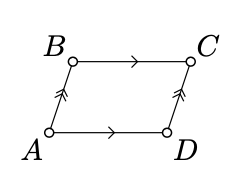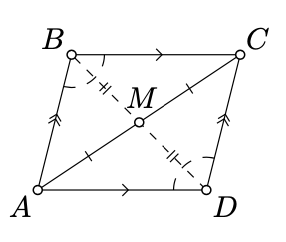7.5: Parallelograms
- Page ID
- 23623

A quadrangle \(ABCD\) in the Euclidean plane is called nondegenerate if no three points from \(A, B, C, D\) lie on one line.
A nondegenerate quadrangle is called a parallelogram if its opposite sides are parallel.
Any parallelogram is centrally symmetric with respect to a midpoint of one of its diagolals.
In particular, if \(\square ABCD\) is a parallelogram, then
(a) its diagonals \([AC]\) and \([BD]\) intersect each other at their midpoints;
(b) \(\measuredangle ABC = \measuredangle CDA\);
(c) \(AB = CD\).
- Proof
-

Let \(\square ABCD\) be a parallelogram. Denote by \(M\) the midpoint of \([AC]\).
Since \((AB)\parallel (CD)\), Theorem 7.2.1 implies that \((CD)\) is a reflection of \((AB)\) across \(M\). The same way \((BC)\) is a reflection of \((DA)\) across \(M\). Since \(\square ABCD\) is nondegenerate, it follows that \(D\) is a reflection of \(B\) across \(M\); in other words, \(M\) is the midpoint of \([BD]\).
The remaining statements follow since reflection across \(M\) is a direct motion of the plane (see Proposition 7.2.1).
Assume \(ABCD\) is a quadrangle such that
\(AB = CD = BC = DA.\)
Such that \(ABCD\) is a parallelogram.
- Hint
-
Since \(\triangle ABC\) is isosceles, \(\measuredangle CAB = \measuredangle BCA\).
By SSS, \(\triangle ABC \cong \triangle CDA\). Therefore, \(\pm \measuredangle DCA = \measuredangle BCA = \measuredangle CAB\).
Since \(D \ne C\), we get "-" in the last formula. Use the transversal property (Theorem 7.3.1) to show that \((AB) \parallel (CD)\). Repeat the argument to show that \((AD) \parallel (BC)\).
A quadrangle as in the exercise above is called a rhombus.
A quadrangle ABCD is called a rectangle if the angles ABC, BCD, CDA, and DAB are right. Note that according to the transversal property (Theorem 7.3.1), any rectangle is a parallelogram.
A rectangle with equal sides is called a square.
Show that the parallelogram \(ABCD\) is a rectangle if and only if \(AC = BD\).
- Hint
-
By Lemma \(\PageIndex{1}\) and SSS, \(AC = BD\) if and only if \(\angle ABC = \pm \measuredangle BCD\). By the transversal property (Theorem 7.3.1), \(\measuredangle ABC + \measuredangle BCD \equiv \pi\).
Therefore, \(AC = BD\) if and only if \(\measuredangle ABC = \measuredangle BCD = \pm \dfrac{\pi}{2}\).
Show that the parallelogram \(ABCD\) is a rhombus if and only if \((AC) \perp (BD)\).
- Hint
-
Fix a parallelogram \(ABCD\). By Lemma \(\PageIndex{1}\), its diagonals \([AC]\) and \([BD]\) have a common midpoint; denote it by \(M\).
Use SSS and Lemma \(\PageIndex{1}\) to show that
\(AB = CD \Leftrightarrow \triangle AMB \cong \triangle AMD \Leftrightarrow \measuredangle AMB = \pm \dfrac{\pi}{2}.\)
Assume \(\ell \parallel m\), and \(X, Y \in m\). Let \(X'\) and \(Y'\) denote the foot points of \(X\) and \(Y\) on \(\ell\). Note that \(\square XYY'X'\) is a rectangle. By Lemma \(\PageIndex{1}\), \(XX' = YY'\). That is, any point on \(m\) lies on the same distance from \(\ell\). This distance is called the distance between \(\ell\) and \(m\).


